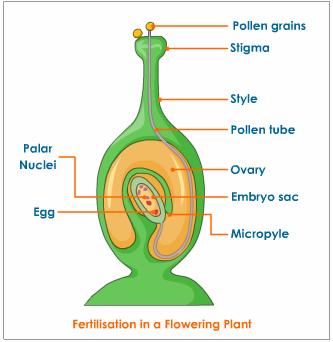
Fertilisation (also known as conception, fecundation and syngamy) is the fusion of gametes to produce a new organism. In animals, the process involves the fusion of an ovum with a sperm, which eventually leads to the development of an embryo. Depending on the animal species, the process can occur within the body of the female in internal fertilisation, or outside (external fertilisation). The entire process of development of new individuals is called reproduction.
After the carpel is pollinated, the pollen grain germinates in a response to a sugary fluid secreted by the mature stigma (mainly sucrose). From each pollen grain, a pollen tube grows out that attempts to travel to the ovary by creating a path through the female tissue. The vegetative (or tube) and generative nuclei of the pollen grain pass into its respective pollen tube. After the pollen grain adheres to the stigma of the carpel (female reproductive structure) a pollen tube grows and penetrates the ovule through a tiny pore called a micropyle.
The pollen tube does not directly reach the ovary in a straight line. It travels near the skin of the style and curls to the bottom of the ovary, then near the receptacle, it breaks through the ovule through the micropyle (an opening in the ovule wall) and the pollen tube "bursts" into the embryo sac.
After being fertilised, the ovary starts to swell and will develop into the fruit. With multi-seeded fruits, multiple grains of pollen are necessary for syngamy with each ovule. The growth of the pollen tube is controlled by the vegetative (or tube) cytoplasm. Hydrolytic enzymes are secreted by the pollen tube that digest the female tissue as the tube grows down the stigma and style; the digested tissue is used as a nutrient source for the pollen tube as it grows. During pollen tube growth toward the ovary, the generative nucleus divides to produce two separate sperm nuclei (haploid number of chromosomes) – a growing pollen tube therefore contains three separate nuclei, two sperm and one tube. The sperms are interconnected and dimorphic, the large one, in a number of plants, is also linked to the tube nucleus and the interconnected sperm and tube nucleuses form the "male germ unit".
Double fertilisation is the process in angiosperms (flowering plants) in which two sperm nuclei from each pollen tube fertilise two cells in an ovary. After the pollen tube reaches the ovary the pollen tube nucleus disintegrates and the two sperm cells are released into the ovary; one of the two sperm cells fertilises the egg cell (at the bottom of the ovule near the micropyle), forming a diploid (2n) zygote. This is the point when fertilisation actually occurs. Note that pollination and fertilisation are two separate processes. The other sperm cell fuses with two haploid polar nuclei (contained in the central cell) in the centre of the embryo sac (or ovule). The resulting cell is triploid (3n). This triploid cell divides through mitosis and forms the endosperm, a nutrient-rich tissue, inside the seed.
The two central cell maternal nuclei (polar nuclei) that contribute to the endosperm arise by mitosis from a single meiotic product. Therefore, maternal contribution to the genetic constitution of the triploid endosperm is different from that of the embryo.
One primitive species of flowering plant, Nuphar polysepala, has endosperm that is diploid, resulting from the fusion of a pollen nucleus with one, rather than two, maternal nuclei. It is believed that early in the development of angiosperm linages, there was a duplication in this mode of reproduction, producing seven-celled/eight-nucleate female gametophytes, and triploid endosperms with a 2:1 maternal to paternal genome ratio.
The process is easy to visualise if one looks at maize silk, which is the female flower of corn. Pollen from the tassel (the male flower) falls on the sticky external portion of the silk, and then pollen tubes grow down the silk to the attached ovule. The dried silk remains inside the husk of the ear as the seeds mature; if one carefully removes the husk, the floral structures may be seen.
In many plants, the development of the flesh of the fruit is proportional to the percentage of fertilised ovules. For example, with watermelon, about a thousand grains of pollen must be delivered and spread evenly on the three lobes of the stigma to make a normal sized and shaped fruit.

No comments:
Post a Comment
Do leave your feedback on the comment box below.